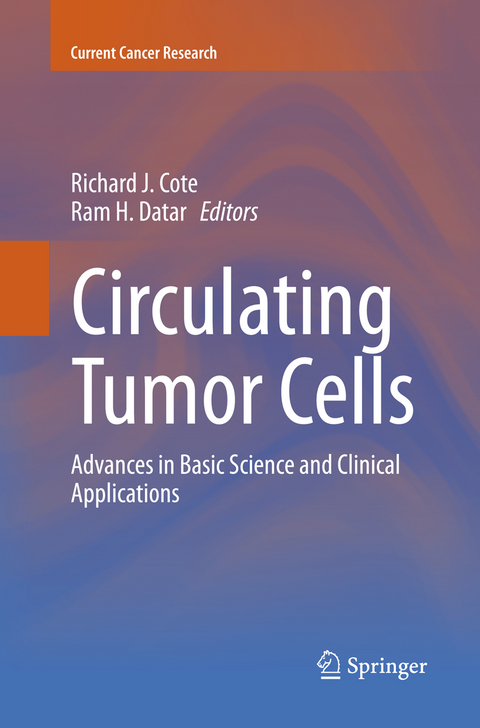
Circulating Tumor Cells
Springer-Verlag New York Inc.
978-1-4939-8031-4 (ISBN)
CTCs are cells that have detached from the primary tumor and circulate in the bloodstream. Such cells may become "seeds" for the growth of additional tumors. The field of analysis surrounding cancer metastasis has been steadily growing, and CTCs provide effective biomarkers that can be examined in peripheral blood through a minimally invasive “liquid biopsy” procedure. CTCs offer several exciting applications, not only as markers of disease progression but also as biomarkers of monitoring response to therapy and companion diagnostics for novel anticancer drug development. In recent years there has been rapid growth and worldwide developments on CTCs, which span both the basic sciences and biomedical engineering fields.
Richard J. Cote, M.D., is Chair, Department of Pathology, the University of MiamiMiller School of Medicine and the University of Miami Health System, andChief of Pathology, Jackson Memorial Hospital. As well, he is Director, the University of Miami Biomedical Nanoscience Institute. Dr. Cote, the recipient of more than $35 million in peer reviewed grant support, holds numerous patents for cancer-related and nanoscale technologies. Dr. Cote also serves as a member and advisor to numerous national and international study groups, cancer programs, and societies—including the National Cancer Institute. The editor and co-author of standard handbooks, Dr. Cote has published more than 300 scientific papers/documents, which have received 10,000 citations. Ram Datar, Ph. D., is Co-Director, Biomedical Nanotechnology Institute, the University of Miami, Associate Professor, Pathology, Associate Professor, Biochemistry and Molecular Biology, the University of Miami Miller School of Medicine. Dr. Datar's areas of research focus include cancer molecular pathology and biomedical nanotechnology. Specifically, he hasbeen involved in various aspects of detection and molecular characterization of occult metastases in cancers. For many years, he has also been involved in the development and application of micro- and nanoscale devices for biomedical diagnostic applications. His goal is to employ microfabrication and development of microfluidic devices to further novel technologydevelopment, including biosensors and molecular methods to analyze expression profiles of cancers. Dr. Datar's many publications have received more than 2,200 citations.
Preface.- Foreword.- Section I. Technologies for CTC Identification.- 1. Significance of Studying Circulating Tumor Cells.- 2. Affinity-Based Enrichment of Circulating Tumor Cells.- 3. Size-Based and Non-Affinity Based Microfluidic Devices for Circulating Tumor Cell Enrichment and Characterization.- 4. Molecular Assays for the Detection and Molecular Characterization of CTCs.- 5. Cancer Stem Cells and Circulating Tumor Cells Molecular Markers, Isolation Techniques and Clinical Implications.- Section II. Fundamental Studies of CTC.- 6. Circulating Tumor Cells and Tumor Dormancy.- 7. Prevention of Conversion of Tumor Dormancy into Proliferative Metastases.- 8. Genesis of Circulating Tumor Cells through Epithelial-Mesenchymal Transition as a Mechanism for Distant Dissemination.- Section III. CTC Analysis.- 9. CTC Analysis FISH, ISH, Array-CGH and Other Molecular Assays.- 10. Genome-Wide Gene Copy Number Analysis of Circulating Tumor Cells.- 11. Perspectives on the Functional Characterization and In Vitro Maintenance of Circulating Tumor Cells.- 12. Prognostic Implications of CTC in Breast Cancer.- Section IV. Potential Clinical Applications of CTC.- 13. CTC in Advanced Breast Cancer Prognosis, Monitoring and Clinical Utility.- 14. Evolution of Metastatic Disease: The Need for Monitoring and Emerging Therapeutic Opportunities.- 15. CTC for Biomarker and Companion Diagnostic Development.- 16. Perspectives on Clinical Applications of CTCs.- Index.
| Erscheinungsdatum | 26.04.2018 |
|---|---|
| Reihe/Serie | Current Cancer Research |
| Zusatzinfo | 29 Illustrations, color; 2 Illustrations, black and white; XXIV, 333 p. 31 illus., 29 illus. in color. |
| Verlagsort | New York |
| Sprache | englisch |
| Maße | 155 x 235 mm |
| Themenwelt | Medizin / Pharmazie ► Medizinische Fachgebiete ► Onkologie |
| Studium ► 2. Studienabschnitt (Klinik) ► Pathologie | |
| Naturwissenschaften ► Biologie ► Genetik / Molekularbiologie | |
| ISBN-10 | 1-4939-8031-9 / 1493980319 |
| ISBN-13 | 978-1-4939-8031-4 / 9781493980314 |
| Zustand | Neuware |
| Informationen gemäß Produktsicherheitsverordnung (GPSR) | |
| Haben Sie eine Frage zum Produkt? |
aus dem Bereich


